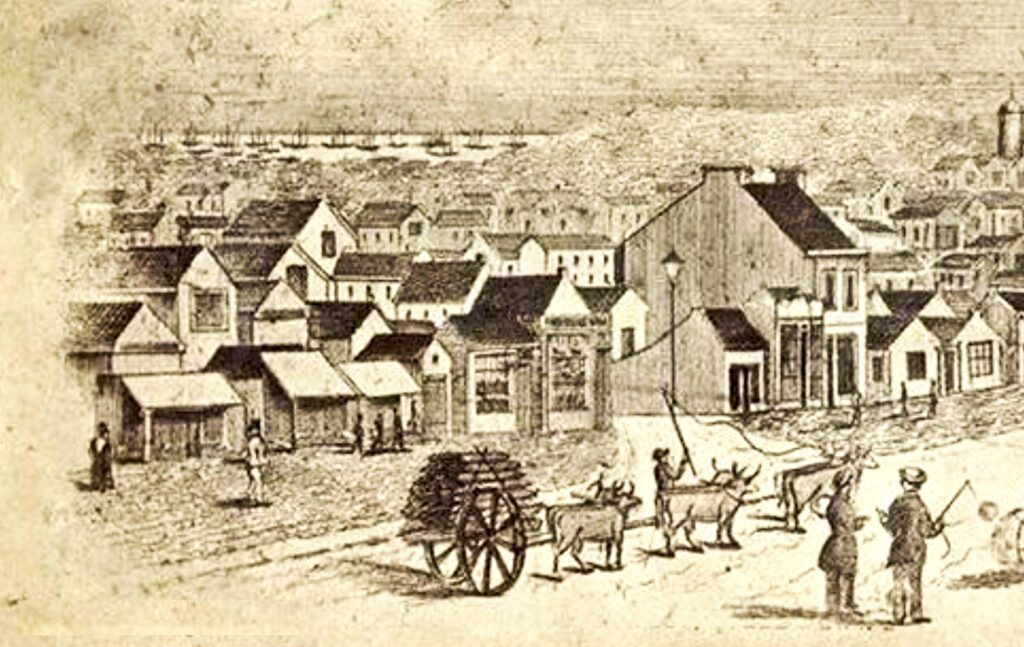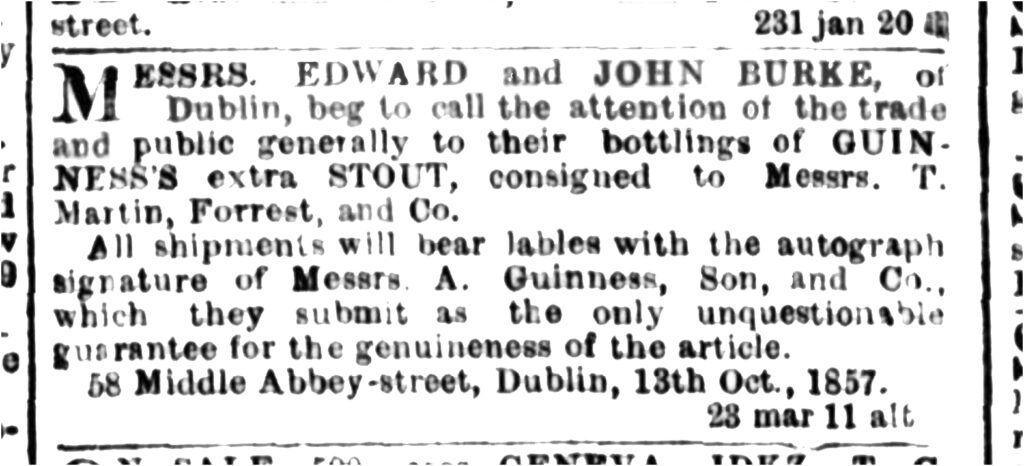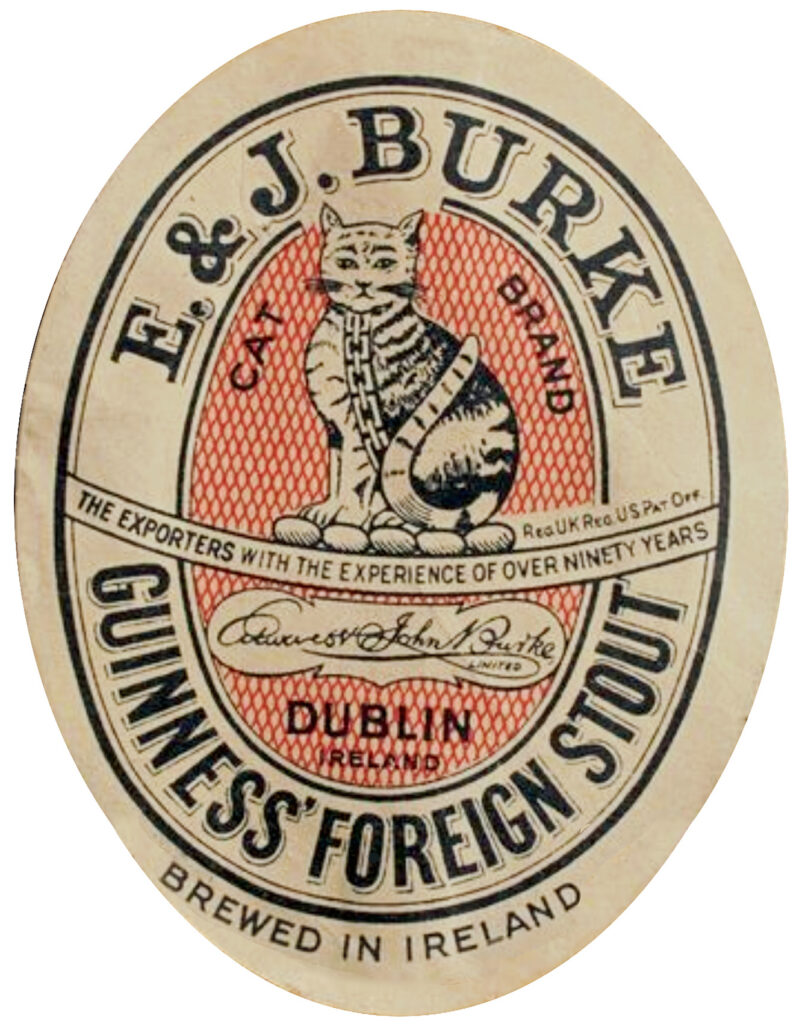Less than two years after Arthur Guinness took over the lease of the St James’s Gate brewery in Dublin, in May 1761, aged 37 or so, he married Olivia Whitmore, a young lady “of distinguished merit, with a real fortune of 2000l.” Olivia was 19, almost half her husband’s age. Her father William, a wealthy Dublin grocer, had died, and at the time of her marriage she was a ward of her uncle, William Lunell, a Dublin trader of Huguenot descent, whose second wife, Ann Grattan, had been the sister of Olivia’s mother, Mary. (Mary Grattan is sometimes said to be a relative of the Irish political leader Henry Grattan: no provable family link is known, however.)
Olivia was to bear Arthur 21 children in total, across 24 years, of whom ten lived to adulthood. Nine of those children married, producing some 56 grandchildren for the Patriarch of St James’s Gate. (In 1843 the second Arthur Guinness complained ungrammatically to one of his cousins, Eliza O’Grady, that “The claims upon us from many, very many Relations, not a few of them Brethren with very large Families, is very great.”)
With all those grandchildren, although many, like Arthur Guinness’s eldest son Hosea, entered the church, there were, inevitably, at least a couple of black sheep. One of the blacker was Arthur Benjamin Burke, born around 1814. He was the second son of Mary Anne Guinness, Arthur I’s youngest child, who had been born in 1787, when her mother was 45. She had married the Reverend John Burke of Ballydugan, Loughrea, Galway, a member of an aristocratic, originally Anglo-Norman family that included the Earls of Clanricarde, and had nine children in total.
Two of Arthur Benjamin’s younger brothers, Edward, born 1827, and John junior, born 1829, went into the wine and spirits trade: Edward was described as wine merchant to his cousin Benjamin Lee Guinness in 1851, when he was 24, and supplied all the wines for the official banquet when Benjamin Lee became Lord Mayor of Dublin. E. & J. Burke were eventually to become one of the very biggest of Guinness’s many independent bottlers, exporting to the United States, Australia and the Far East, using a cat, taken from the Burke family crest, as their trademark. Arthur Benjamin Burke had been given an apprenticeship at the St James’s Gate brewery in 1831, aged 18 or so, but apparently left under a cloud – one source claims he was dismissed because of excessive drinking.
After some time in London, where he may have worked for his brothers’ wine and beer business, early in the 1850s Arthur Benjamin emigrated to Australia with his wife, Margaret D’Arcy, née Ryan, and family, including Margaret’s son by her first marriage, Thomas, born 1833, and their own son, Arthur, born around 1839. Margaret was a Catholic, and this may have caused problems with Arthur’s strictly, and very Protestant family, both the Burkes and the Guinnesses: the pair never actually married until 1848, in London.

Arthur and his family arrived in Melbourne, Victoria in October 1853. The city was in the middle of a boom, after gold had been discovered in Victoria. By the middle of 1856 Arthur Benjamin Burke had found a job as a brewer at the Union Brewery, 128 Little Lonsdale Street, junction with King Street, on the western side of the city, about half a mile north of the Yarra river. The brewery was run at the time by J.W. Allen & Co. (sometimes found as Allan). Allen & Co. decided to use Arthur Benjamin’s family links by cheekily renaming its premises the Guinness Brewery, Melbourne, and announcing that it had engaged as a brewer “Mr A.B. Burke, nephew of the famous Arth. Guinness, Esq, and who for many years was assistant brewer to the firm of Arthur Guinness, Son and Co of Dublin.” As a result, the brewery declared, it could “with confidence offer an article similar to Guinness’s Dublin Stout.” The following month the firm placed an advertisement in the Melbourne Argus saying: “Wanted Families to buy Double Stout at the Guinness Brewery, 128 Little Lonsdale Street west, corner of King street.”

To claim that Arthur Benjamin Burke had been “for many years assistant brewer” at St James’s Gate was a fib, at best, but he could not have been too bad a brewer: in November 1856 Messrs Allen & Co of the Guinness Brewery, Melbourne won a silver medal at the Victoria Industrial Exhibition for its XX porter “brewed by Mr A.B. Burke, nephew of the celebrated Guinness of Dublin.”
In October 1856 Allen took as his new partner at the Guinness Brewery Robert Crawford, “late City Inspector”. The business was still running as “Guinness’s Brewery” in September 1857 when it was advertising “that In Consequence of the kind Patronage received by the Proprietors, they have determined to reduce the price of their Draught Porter form 4s to 3s 6d per gallon. To parties bringing their casks to be filled, the price will be 3s per gallon,” a move that suggests “the kind Patronage” was, despite its kindness. not actually buying enough beer to keep the business viable.
Presumably Burke and the brewery owners felt that, since they were almost 11,000 miles from Dublin in a straight line, 14,000 miles by sea, they were far enough away that no one at St James’s Gate would notice they had stolen the Guinness name. However, it looks as if they had been rumbled: early in 1858 the Melbourne Argus newspaper began carrying advertisements from Arthur’s brother’ firm stating forcefully: “MESSRS. EDWARD and JOHN BURKE, of Dublin, beg to call the attention of the trade and public generally to their bottlings of GUINNESS’S extra STOUT, consigned to Messrs. T. Martin, Forrest, and Co. All shipments will hear labels with the autograph signature of Messrs. A. Guinness, Son, and Co., which they submit as the only unquestionable guarantee for the genuineness of the article.”

The brewery seems to have changed hands at some point around this time, because in October 1857 The Argus newspaper carried a notice announcing that “Arthur Benjamin Burke, formerly Assistant Brewer to the firm of Messrs Arthur Guinness, Sons [sic – it was Son] and Co of Dublin” had ceased his connection as brewer to the brewery carried on by Hopwood, Butler and Co from September 25. Nothing more seems known of Hopwood and Butler, or even if they were definitely in Little Lonsdale Street. However, the business in Little Lonsdale Street continued using the Guinness name: in December 1857 it was advertising “Yeast, in any quantity, One Shilling per Gallon, The Guinness Brewery, Little Lonsdale-street.”
It appears the business had a new owner yet again by August 1858, when a brewer named William Crellin seems to have taken over in Little Lonsdale Street. A year later the brewery was still trading under the St James’s Gate firm’s name, when James Affleck joined William Crellin & Co in April 1859 and “the business will henceforth be conducted under the style of Crellin and Affleck, Guinness’s Brewery, 128 Little Lonsdale Street west.” That same month “Guinness Brewery, 128 Little Lonsdale-street, West” was advertising for “a strong man to grind malt.” However, early in 1860 Crellin and Affleck were declared insolvent, and that March the contents of Guinness’s Brewery in Little Lonsdale Street West were put up for auction: they included, as well as the goodwill and all the plant, “about five tons of damaged raisins” and 100 hogsheads of vinegar.

The Guinness brewery and its plant, capable of producing 44 hogsheads (66 barrels) a week, was advertised for let in April 1860. The lease was evidently acquired by a man named William Whitmore, who was advertising for “Barley to Malt. Any quantity” at the Guinness brewery in August 1860. The same month the Guinness Brewery in Little Lonsdale Street was advertising for “a Collector”. Four months later, in December 1860, the Guinness Brewery malt house at 155 Lonsdale Street west was advertised for letting, with “extensive premises”. Nothing is known of the next 18 months in Little Lonsdale Street, but in July 1862 the “”premises known as the Guinness Brewery” were available “to let cheap.” It was still unlet eight months later, in March 1863, the rent now “very low”
It seems Arthur Burke departed the Little Lonsdale Street brewery without leaving a forwarding address: early in December 1857 a small ad had appeared in The Argus, Melbourne, saying: “Mr Burke, late of Guinness’s Brewery, Melbourne — please leave your address with Mr Bayley, Exchange Hotel, Swanton-street.” Two months later, in February 1858, The Argus carried yet another targeted small ad: “Mr Arthur Benjamin Burke is requested to call upon the Rev Mr Guinness, South Yarra, immediately he sees this.” That was one of Arthur’s many cousins, the Reverend William Newton Guinness (son of Arthur’s uncle William Lunell Guinness), who had emigrated to Australia in 1856 to become rector of Christ Church, South Yarra: the family was evidently looking for him as well.
After leaving the Little Lonsdale Street brewery, by the summer of 1858 Arthur Burke was working at the Eagle brewery, Richmond Bridge Road, on the east side of Melbourne, when he inserted a small ad in The Argus that read: “Praveter wanted,” presumably a typo for “partner”. (The brewery had been advertised as “to let” five months earlier.) The Eagle brewery, not to be confused with a later Eagle brewery in Spencer Street, Melbourne, was presumably the brewery in Richmond where Arthur was brewing in 1863, when he was in partnership with Walter Wiggins and working under the name “Arthur Guinness Burke.” (It has been suggested that their brewery was renamed the Dublin Brewery: this appears to be a different concern.)
That autumn, Burke and Wiggins bought 60 bushels of malt, together with hops, from two Melbourne merchants called William Gardiner Sprigg and Richard Twentyman, and turned it into some 600 or 700 dozen bottles of porter. Finding themselves unable to raise the cash for the malt and hops they had been supplied, Burke and Wiggins handed over at least 300 dozen bottles of that porter to Sprigg and Twentyman in payment for the raw materials. Sprigg and Twentyman had an argument with Burke and Wiggins over the labels on the bottles: according to Sprigg the two brewers wanted to use labels falsely claiming it had been brewed by Guinness’s in Dublin and bottled by Arthur’s brothers’ firm, E. & J. Burke, which had been exporting Guinness’s stout to Australia since at least 1857. Sprigg insisted on a label which bore the inscription “Arthur Guinness Burke, late of Arthur Guinness and Co, Dublin,” and he also demanded a letter from the Reverend William Lunell Guinness confirming that Arthur Burke was a nephew of Arthur Guinness II and had worked at the St James’s Gate brewery.
The porter ended up with a storekeeper called Lawrence Dale in Morse’s Creek (today the town of Bright), some 130 miles from Melbourne. By the time it reached Morse’s Creek it was undrinkable, however, according to Dale, and in March 1865 he sued Sprigg and Twentyman in the Victoria Supreme Court for the cost of the porter, £116 5s. During the court hearing, Walter Wiggins, who was now working as a saddler, revealed that “hundreds and thousands” of fake Guinness labels were on sale in Queen Street, Melbourne. He also said that the porter handed over to Sprigg and Twentyman was “not fit to be sent up the country,” and should have been kept for use in Melbourne and drunk quickly: “After the first fermentation this porter goes down flat, and never comes up again, because there is so much old ale put in, to give it a twang of Guinness’s; and it gets like dish water when once it goes down.”
Dale lost his case, since he had not bought directly from Sprigg and Twentyman, and there was thus no contract between him and them. The day after the court case was reported in Melbourne’s newspapers, Arthur, writing under the name Arthur Guinness Burke, sent a letter to The Argus from Alma Street, Fitzroy, Melbourne saying that he “positively” denied brewing the porter that had been at the center of the dispute, since his connection with the brewery in Richmond had ended on September 20 1863. Unfortunately for him, Sprigg, Twentyman and Co’s records showed that Arthur had not just brewed the beer but had actually brought the porter to the firm’s storehouse, at least four days before September 20.
What happened after Arthur left the brewery in Richmond is unknown, but he was still described as “brewer” when, the year after the court case, he died of cholera and diarrhoea, aged 51 or so, on January 31 1866 at 5 Victoria Street, West Melbourne.
Arthur’s son, Arthur Burke junior, became a brewer too, and apparently worked for the Hope Brewery on Richmond Flat, Melbourne, but died of tuberculosis in June 1873. Arthur senior’s stepson, Thomas D’Arcy Burke, also entered the brewing profession, and led a peripatetic and largely successful life: certainly more successful than his stepfather. He was head brewer for a while at Thomas Aitken’s Victoria Parade brewery in Melbourne (co-incidentally, Aitken had founded the Union Brewery in Little Lonsdale Street) and at Sime and Syson’s Adelaide brewery, and owned the Flagstaff brewery in Melbourne between 1874 and 1879. Thomas bought the Union Brewery in Adelaide with W. R. Sawers in 1883. In 1887 he co-founded the Waverley Brewery in Broken Hill, New South Wales, before leaving two years later to run the Unicorn Brewery in Silverton, NSW. Unfortunately, although by now Thomas had won 32 prizes for bottled ale and stout, the brewery went into liquidation in 1890.
In 1895 Thomas bought the Clarence River Brewery in Maclean, NSW, and ran it until he closed it in 1901. He was briefly involved with the Albion Brewery in Wagga Wagga, NSW, but he was now 68, and doubtless ready to retire. He died in Manly, NSW, aged 79. His youngest son, John D’Arcy Burke, born in Adelaide in 1883, entered the brewing profession too, working for Tooth’s brewery in Sydney.




Another outstanding piece of stout and porter history. Part of your upcoming book on the subject, one hopes?